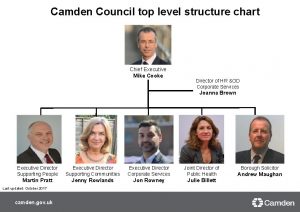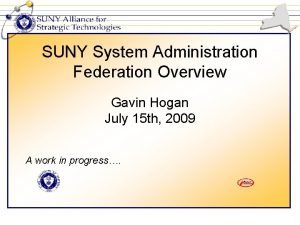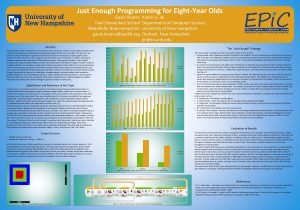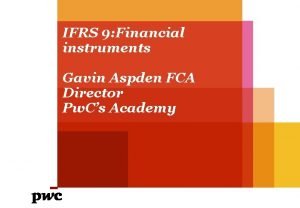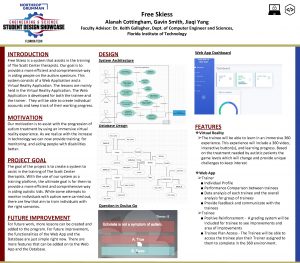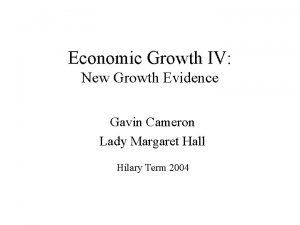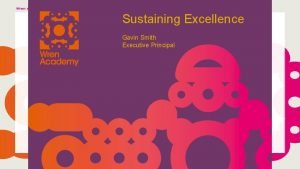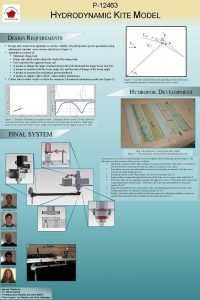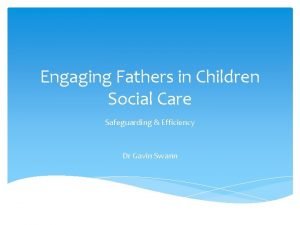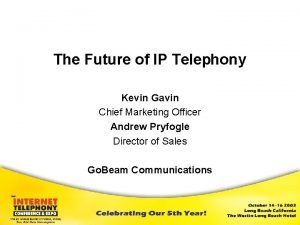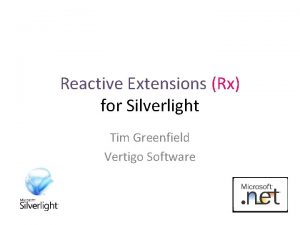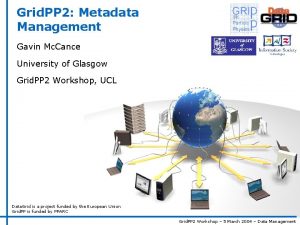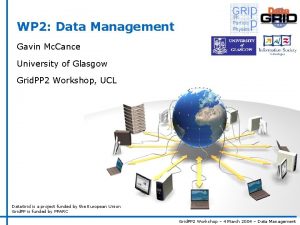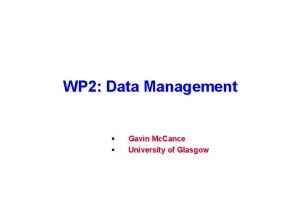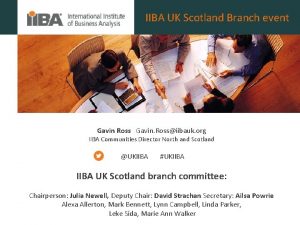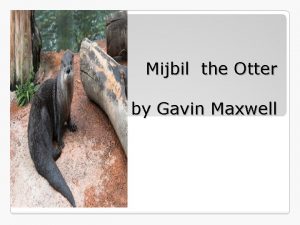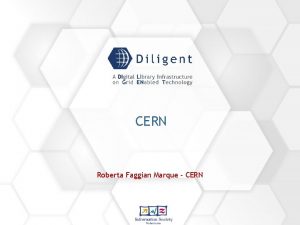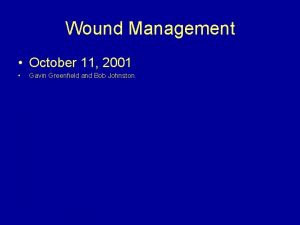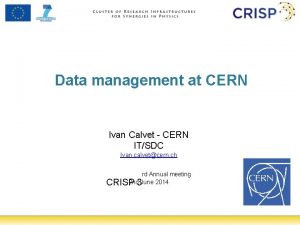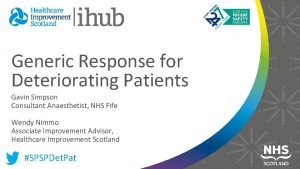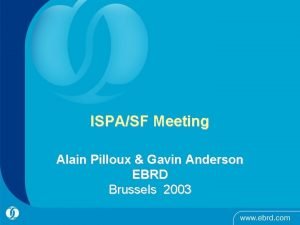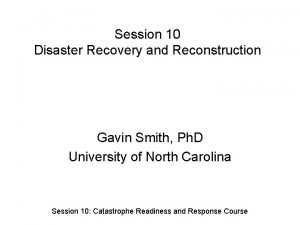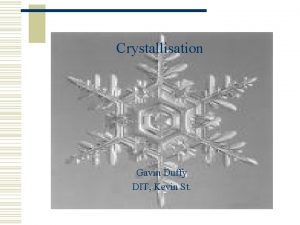CERN IT Systems Management Gavin Mc Cance CERN


























- Slides: 26


CERN IT Systems Management Gavin Mc. Cance CERN IT-CM

Outline • • • General strategy Puppet for configuration Automation Data-centre and service monitoring Data-centre capacity plans Cloud and containers 13 April 2016 2 nd Workshop on DAQ 3

LHC compute scaling challenges Compute: Growth > x 50 What we think is affordable unless we do something differently 13 April 2016 2 nd Workshop on DAQ 4

Good News, Bad News • Additional data centre in Budapest now online • Increasing use of new facility as data rates increase But… • Materials budget decreasing, no more money • Staff numbers are fixed, no more people • Legacy tools are high maintenance and brittle • User expectations are for fast, dynamic selfservice 13 April 2016 2 nd Workshop on DAQ 5

General strategy • As we scaled-up and made things more dynamic, our home-baked tools started to break and we struggled to find the effort to fix them • How can we avoid the sustainability trap? • • Really try hard to not develop our own stuff Avoid accumulating technical debt The major driver for the Agile Infrastructure was to control the technical debt How can we learn from others and share? • • • Find compatible open source communities Contribute back where there is missing functionality Stay mainstream Are CERN computing needs really special ? 13 April 2016 2 nd Workshop on DAQ 6

O’Reilly Consideration • 13 April 2016 2 nd Workshop on DAQ 7

CERN Tool Chain 13 April 2016 2 nd Workshop on DAQ 8

Puppet for configuration • Puppet roll-out has worked well for us • ~300 service manager with ~200 distinct hostgroups, both IT and experiment services Positive user experience • Excellent open community support • • Lots of standard modules We’ve complemented this with a library of standard CERN configurations Solid APIs hooks for automation 13 April 2016 2 nd Workshop on DAQ 9

Why Puppet? • Several other obvious alternatives (Ansible, Chef, cf. Engine, …) • Puppet’s declarative language model fitted our users’ expectations (similar to previous tool) Centralised service model works well in our environment • • Solid community and good upstream support • This is the most critical aspect for anything you might chose • We’ve invested in Puppet and we’re still very happy • We’ve no plans to move to anything else anytime soon : ) 13 April 2016 2 nd Workshop on DAQ 10

Configuration service plans • Faster versions of Puppet in the pipeline • Potentially replace some of our own stuff (e. g. secrets management) with products that community have subsequently released • Focus now on automation 13 April 2016 2 nd Workshop on DAQ 11

Ops automated testing • Focus is now on automation to control ops cost as we expand capacity • “Continuous Deployment” combining gitlab-ci, puppet, Openstack orchestration • • Aim is to automatically test as much as possible before rolling out a change to production Working on making it easy to do this for all service changes with easy-to-add validation tests for automated “qa” testing 13 April 2016 2 nd Workshop on DAQ 12

Ops automation tools • Lots on the open and open++ market • • Stackstorm, Cloudify, Saltstack, Rundeck, … Several teams in IT using Rundeck just now • Aiming at event-based automated recovery • “Monitoring has not heard from this service for a while / has seen high-load” • • • kick off a canned investigation / fix job Everything in our infrastructure is now an API Rule #42: Only raise to a human when you run out of things to try 13 April 2016 2 nd Workshop on DAQ 13

Infrastructure monitoring ‘Lemon monitoring service” backend now replaced by standard, open technologies • Node metrics collected by Flume • • • Funneled to Elastic. Search for dashboards, Spark for online analysis and Hadoop for subsequent analytics Node exceptions (i. e. metrics out of bound) transported by Active. MQ messaging • • Can be subscribed to for automation events Main “subscriber” is our Service. NOW 13 April 2016 2 nd Workshop on DAQ 14

New infrastructure monitoring (meter. cern. ch, based on Kibana/ES) 13 April 2016 2 nd Workshop on DAQ 15

Infrastructure Monitoring futures • Investigating further dashboard technologies and backend data stores • • Currently Elastic. Search and Kibana Influx. DB as possible backend Graphana as possible dashboard Lemon agent replacement -> collectd? • • • Lower maintenance: replace all standard metrics Make it cheap to create new metrics Translation layer for residual Lemon sensors 13 April 2016 2 nd Workshop on DAQ 16

Service monitoring • ETF framework (from the WLCG SAM) based around check. MK and Nagios Huge library of service check available • • Currently used for monitoring services across the WLCG for availability reporting • Extending soon to local service monitoring i. e. is a service doing what it’s supposed to be doing Useful directly for service managers • • e. g. service dashboards • …but also an automated service recovery trigger • 13 April 2016 2 nd Workshop on DAQ 17

Streaming and analytics • Lemon metric / exception / ETF streams can be monitored in real-time by Spark / Kafka or Esper Register jobs hunting in real-time for more complex patterns. . . firing a trigger Event based automation • • • Hadoop analytics All data poured into Hadoop Longer term problem investigation using analytics • • • e. g. understanding inefficiencies in the batch system 13 April 2016 2 nd Workshop on DAQ 18

Physical DC Infrastructure • CERN Main Data Centre 3. 8 MW for computing of which ~2. 3 MW currently used • • Remote hosting site (Wigner Data Centre in Budapest) 2. 7 MW for computing of which ~1 MW currently used • • • Due to low rack power density, majority of available rack space currently used Contract until end of 2019 but could be extended by 1 -2 years (if necessary) 13 April 2016 2 nd Workshop on DAQ 19

Options for additional capacity • • No firm plans yet. No plan to upgrade the Meyrin Data Centre further as it is considered that it would not be cost effective • Investigating commercial clouds or external hosting as an option for providing additional capacity • There is the option to do another tender for a remote hosting facility such as Wigner either as a sole solution or in combination with commercial cloud resources • A final option, although not yet investigated in any way yet, would be a modular Data Centre addition, similar to the approach foreseen for LHCb and ALICE for post LS 2 needs 13 April 2016 2 nd Workshop on DAQ 20

How to integrate external capacity? • Critical for ops cost to manage any external resources with same tools as we do here • • • Puppet / common monitoring Possible restricted use-cases Being tested now on IBM Softlayer / TSystems Further procurements planned (HNSci. Cloud) Aim to expose (compute) resources only via common HTCondor lxbatch interface • one place to submit to for any CERN compute work 13 April 2016 2 nd Workshop on DAQ 21

Private cloud • • Happy with Openstack Cloud model has allowed us to scale within fixed manpower • • Emulate legacy environment – most services moved to VMs Enable new ways of working But difficult to avoid divergence / segmentation in fixed DC Collaborations with open source and industry covers technical debt • • • Future maintenance and testing External mentoring avoids special solutions Enhance staff job opportunities 13 April 2016 2 nd Workshop on DAQ 22

Private cloud plans • Keep running the cloud • • New releases every 6 months Around 2, 000 servers / year to renew Integrate bare-metal management with Openstack Change the cloud – variety of new things in the pipeline • • • Containers Software Defined Networking Fine grained accounting and quota 13 April 2016 2 nd Workshop on DAQ 23

Container technology • Potentially, a very lightweight way to deploy services • Focus on application code and scaling behaviour rather than deployment • Various use cases: R as a Service, Jupyter notebooks for HEP analysis, pre-packaged batch jobs We’re testing Magnum from Openstack • Will deploy and scale for you a Docker Swarm, Kubernetes or Mesos instance • • • Technology evolving very quickly in this space Aim to track and offer stable service • CERN ITTF: https: //indico. cern. ch/event/506245/ 13 April 2016 2 nd Workshop on DAQ 24

Summary • • • We’ll keep doing configuration with Puppet Now focusing on the change testing and recovery automation Monitoring based on standard technologies; understanding which tools are best • • Various options for extending compute capacity • • • Looking how best to integrate the monitoring with our automation efforts Validating providers, tools and experiment payloads in various providers now No firm decisions yet Private cloud with Openstack – very happy with it • Manpower scaling well 13 April 2016 2 nd Workshop on DAQ 25

Summary • • Moving to a set of solid, open-source based community products has helped us a lot New technologies, as they come along, are typically integrated quickly • • Though you have to invest manpower to keep things up to date Plus side -> any development effort you do (should be) integrated upstream We’re happy with the Puppet / Openstack ecosystem and would recommend it We believe we have a solid base which will serve us for a long time yet 13 April 2016 2 nd Workshop on DAQ 26
 Ending gavin ewart
Ending gavin ewart Gavin cotter
Gavin cotter Gavin haynes camden
Gavin haynes camden Suny central administration
Suny central administration Gavin baldwin
Gavin baldwin Gavin cameron
Gavin cameron Gavin cook princeton
Gavin cook princeton Gavin kearns
Gavin kearns Gavin cameron
Gavin cameron Gavin aspden
Gavin aspden Pc gavin smith
Pc gavin smith Gavin cameron
Gavin cameron Gavin davies imperial
Gavin davies imperial Gavin corey
Gavin corey Gavin smith wren academy
Gavin smith wren academy Causes of cyanosis
Causes of cyanosis Gavin soorma
Gavin soorma Gavin is designing a kite
Gavin is designing a kite Gavin giovannoni
Gavin giovannoni Gavin swann
Gavin swann Andrew pryfogle
Andrew pryfogle Gavin greenfield
Gavin greenfield Index of soorma
Index of soorma Wendy gavin
Wendy gavin Decision support systems and intelligent systems
Decision support systems and intelligent systems Engineering elegant systems: theory of systems engineering
Engineering elegant systems: theory of systems engineering Embedded systems vs cyber physical systems
Embedded systems vs cyber physical systems


